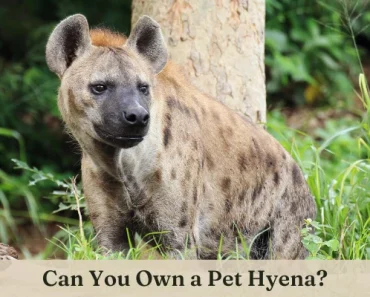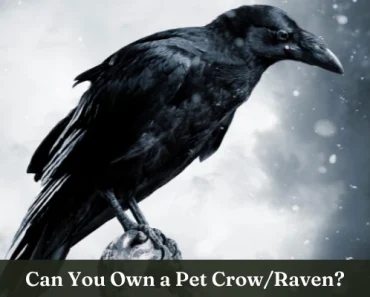Having a bird of prey such as a hawk as a pet is a desired trait for many exotic pet owners.
Having a pet hawk may be desired but there are many hurdles and roadblocks to get through before you can own a hawk, usually not to be a pet though.
This article provides an in-depth look into the bird of prey or raptor, the hawk. Find out where or if hawks can even be kept as pets.
Learn why they would or wouldn’t make great pets, what they eat, their characteristics, and whether it is legal to own a pet hawk.
Can You Have a Pet Hawk?
Hawks are protected under the Migratory Bird Treaty Act of 1918, which prohibits the capturing, killing, trading, and transporting of any birds protected under this treaty.
The only exception is for licensed falconers to get prior authorization from the Department of Interior U.S. Fish and Wildlife.
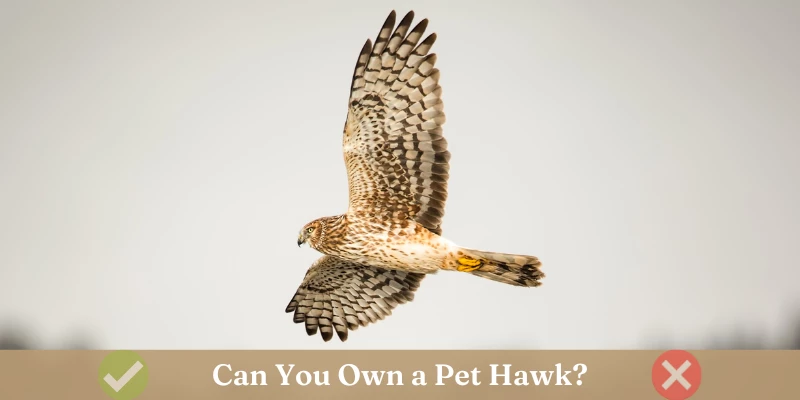
Can You Have a Pet Hawk in The United States (U.S.)?
All hawks fall under the Migratory Bird Treaty and hawks as pets are illegal in the United States. This includes the capture, kill, trade, and transport of any hawk within the U.S unless you have been authorized prior by the Department of Fish and Wildlife.
This means you are not allowed to have a hawk as a pet in the United States, whether from the wild or an exotic pet dealer.
Can You Have a Hawk as a Pet in Canada?
In Canada, hawks fall under the Migratory Bird Treaty Act, and having a pet hawk in Canada is illegal just like in the states. The only exception is for licensed falconers that have been given prior authorization by becoming a licensed Master Falconer.
The Migratory Bird Treaty Act protects any bird species that are native to that state, country, or region.
Can You Have a Hawk as a Pet in Australia?
Pet hawks are not legal in Australia without a valid and special permit. These permits are not easy to get and are usually reserved for parks, zoos, and conservation projects.
Most wildlife in Australia requires special permits, including hawks, kangaroos, koalas, quokkas, wombats, and many other wild animals.
Can You Have a Hawk as a Pet in The United Kingdom (UK)?
Hawks are protected under the Wildlife and Countryside Act 1981, which prohibits the injuring, killing, taking, disturbing, and trading of wild animals (including hawks).
Hawks are considered birds of prey or raptors and have specific laws that accompany owning one, whether it be owning a hawk as a pet or for falconry purposes.
Any bird of prey must be registered in most cases and different regions have different laws about owning pet hawks or for any other purpose.
Are Hawks Good Pets?
Hawks are not considered to be good pets for the majority of pet owners. Having a pet hawk requires lots of training, maintenance, special accommodations, and specific diets…and that is just scratching the surface.
That is assuming you can even get past the legal hurdles of owning a hawk as a pet, which is illegal in most places.
Why Are Hawks Not Good Pets?
Having a pet hawk is a bad idea for many reasons, but one of the main reasons is that they are illegal for most pet owners unless you have obtained a Master Falconer license, which is not easy to obtain.
Aside from being illegal in most countries and regions (including all of the United States), having a hawk as a pet is not a good idea because they are birds of prey, they are mostly solitary animals, and they are not that fond of humans and tend to avoid us when possible.
Hawks require a significant amount of training and have the instinct of a predator.
Unless kept and trained from an early age, it would be fairly difficult to domesticate a wild hawk into a pet hawk because it has already reached adulthood.
Hawk Physical Attributes
Hawks have a wide range of physical attributes and characteristics. There are a variety of different species (about 270 total) that are considered hawks.
They can range anywhere from a few ounces to over ten pounds in weight and a few inches to several feet in length – with females usually being larger than males.
The majority of hawks have hooked or curved bills (beaks), sharp talons, and a predator mindset.
Hawks are considered “birds of prey” and also “raptors” because of their talons and their ability to grip or grasp their prey using their sharp talons, which hawks also use to typically kill their prey or to defend against other predators.
They have excellent eyesight that helps them see prey from a significant distance. Not only can they see far but their eyesight is much clearer than ours and many other animals.
Hawk Behavior & Temperament
Below are common questions related to a hawk’s behavior and temperament.
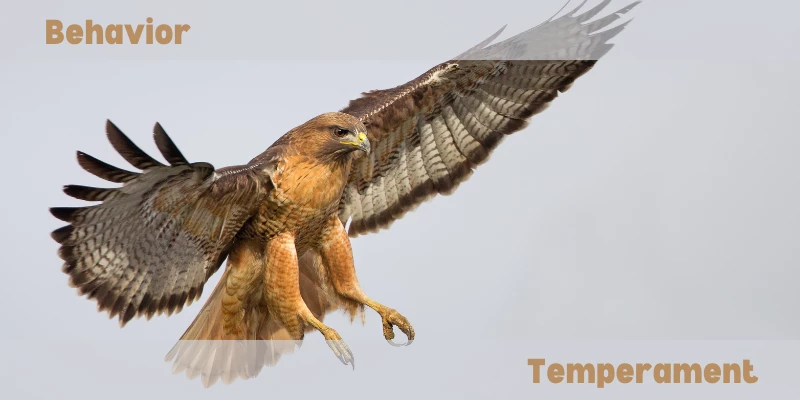
Are Hawks Aggressive?
Hawks are not typically aggressive toward human beings and try to avoid us as much as possible. However, during the breeding season, being around a hawk’s nest might change their behavior.
Hawks will become aggressive toward humans if they feel their eggs or young are in danger, so be careful being around a nest (which is also true for most bird species).
Are Hawks Dangerous?
Hawks are usually not dangerous to people unless these animals feel threatened. As stated, hawks can become dangerous during the breeding season and if you get too close to their nests.
Some can be more dangerous than others depending on the size and the species of hawk.
Are Hawks Affectionate?
Hawks are not affectionate or friendly toward humans. They would prefer to avoid humans as much as “birdly” possible.
Even in captivity with their handlers, hawks still tend to not show a great deal of affection or friendliness.
Of course, this varies from bird to bird and is based on the handler as well, but generally speaking, hawks are not friendly animals.
Are Hawks Solitary?
Hawks are mostly solitary with a few exceptions. The exceptions include when they are spending time with a mate around springtime or migrating to a warmer client during the cold season.
Some small groups might be found together in other circumstances, but this is not the normal behavior for most hawk species.
Are Hawks Territorial?
Hawks can be very territorial birds. Some species keep the same mate for life but don’t associate with other birds.
These animals are not usually social and stick to small groups consisting of very few or only together as a pair for mating purposes.
What Do Hawks Eat?
Depending on the species, small animals are the preferred food choices for most hawks. Hawks eat small animals such as:
- Chipmunks
- Frogs
- Gophers
- Insects
- Lizards and other small reptiles
- Mice/Rats
- Rabbits/Hares
- Snakes
- Turtles
And possibly even some pets depending on the size and species of the hawk.
Hawk Habitat
Hawks live in a variety of many different habitats. Since hawks are found all around the world, they’ve adapted to many different habitats.
Hawks In the Wild
Hawks are found in many different countries and regions around the world.
Wild hawk habitats can range from being in trees, bushes, or even on the ground around marshes, depending on the region and the species of hawk.
Hawk as a Pet
Since the laws prohibit having a hawk as a pet in most countries, this doesn’t apply to most people.
But if you happen to be in a place where you can have a hawk as a pet, you will need to ensure you have a large enclosure or have a very trained bird because hawks need a great deal of space to move around and fly in.
How Much Do Pet Hawks Cost?
Hawk prices range widely depending on many factors, but expect to pay a good amount for any hawk no matter where you are located.
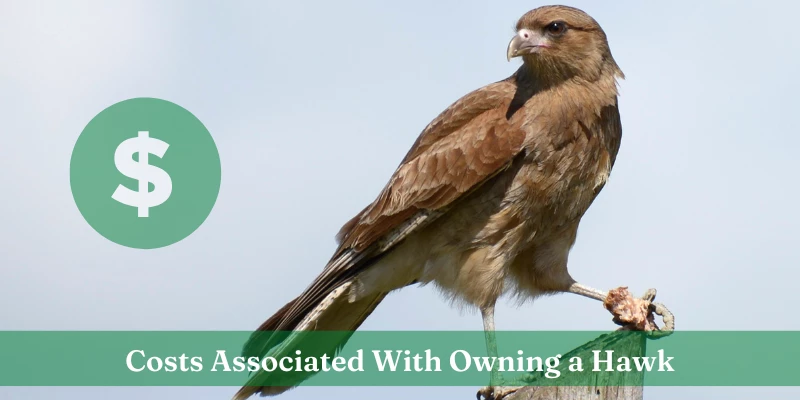
Initial Cost to Purchase a Pet Hawk
The cost to purchase a hawk as a pet can range between $600 to over $1,000 depending on the species, your location, and the gender of the hawk.
Some can have an even higher price tag of around $5,000 depending on how scarce and what type you are looking to purchase.
To own a pet hawk, you are going to be looking at a significant price tag and that is just for the initial purchase.
Ongoing Costs to Own a Pet Hawk
Aside from the initial cost to own a pet hawk, you will need to factor in other costs like habitat, diet, and any special needs that the hawk may need, including vet visits.
These costs can range significantly, so I don’t feel comfortable just throwing out some numbers.
Like other exotic animals, hawks as pets will cost more than your average domesticated pet like cats and dogs.
Where Can I Buy a Pet Hawk?
Hawks for sale as pets are not something you will find on the exotic breeder market. Hawks are for sale to master falconers with the appropriate permits.
If you have become a master falconer with the correct permits, you can check out hawks for sale at the websites listed in the next section.
Purchase a Pet Hawk
Here are some websites where you may buy a hawk if you have the right permits and have become a master falconer.
Adopt a Pet Hawk
I do not know of any services or companies that provide physical adoption of any hawks as pets, but you can symbolically adopt a hawk as a pet from any of these organizations.
45 Commonly Asked Questions About Hawks
Below is an extensive list of 45 commonly asked questions related to hawks.
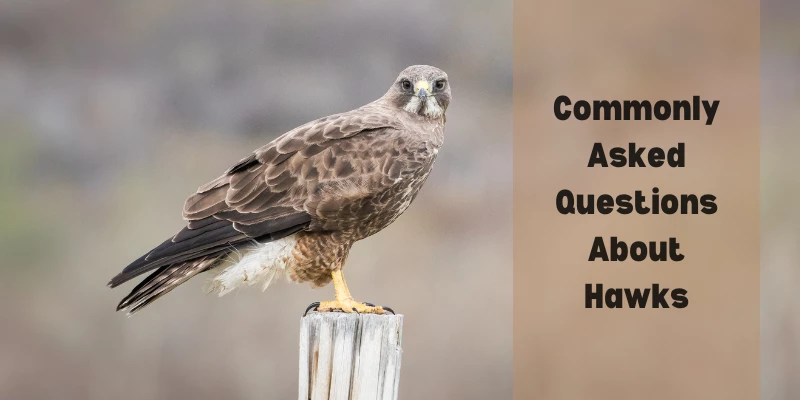
1. Do Hawks Eat Humans?
Hawks do not eat humans because we are not prey for hawks. It is in a hawk’s nature to avoid humans as much as they possibly can.
Hawks prefer their meat fresh and don’t usually eat anything dead for a while, including human carcasses.
2. Can a Hawk Pick up a Human?
No, there is no known species of hawk that can pick up a human being. The hawk would have to weigh around the same as a human to have the strength to pick them up.
Most birds weigh nowhere near that with the majority being only a few pounds or less.
3. Do Hawks Eat Dogs?
Hawks don’t normally eat dogs but they may see smaller dogs as prey and attempt to catch them.
While this is rare, it has happened on occasion.
So if you have a hawk around your house or yard, you should keep a close eye on your dog.
4. Can a Hawk Pick up a Dog?
Most hawks species will not be able to pick up a dog and carry it into the air.
Since most hawk species only weigh a few pounds or less (some weight even less), it would be impossible for the majority of hawk species to pick up a dog since they don’t usually have enough strength to carry anything that weighs more than their own body.
5. Do Hawks Eat Cats?
Hawks have an abundance of wild prey and usually don’t go after pets, including cats.
However, given the right opportunity and situation, it isn’t unheard of for a hawk to attack a cat or similar pet.
These occasions appear to be rare, but caution is always best.
6. Can a Hawk Pick up a Cat?
A hawk may be able to pick up a kitten, depending on its size and weight. But most hawk species would not be able to pick up an adult cat due to their weight and size.
7. What Can Eat a Hawk?
Many predators can eat hawks. It is just hard for hawks to be caught by predators considering they spend most of their time in the air or in a high tree.
Some of these predators include eagles, larger hawks, foxes, owls, raccoons, and certain species of snake.
8. Are Hawks and Eagles the Same?
Hawks and eagles have similar builds and characteristics, but they are not the same species. They do belong to the same family of birds though, the Accipitridae family. Both species are birds of prey.
Eagles are bigger than most hawks and have much wider wingspans.
Hawks have stockier bodies with rounded wings and shorter, rounded tails than eagles.
9. Are Falcons and Hawks the Same?
Falcons and hawks are two different species of birds. Both species are birds of prey and raptors. Hawks tend to be slightly larger than falcons while falcons tend to have a longer wingspan.
Falcons like the open plains and similar areas while most hawk species have habitats in a variety of different settings including deserts, forests, fields, mountainous terrain, and tropical regions.
10. What Kind of Bird Is a Hawk?
A hawk is known as a bird of prey or a raptor. They are in the Accipitridae family, range in various sizes, and are adaptable to many different habitats.
11. Is It Good to Have a Hawk in Your Yard?
A hawk can be good to have in your yard if you are having a vermin problem. Hawks hunt small animals for food including chipmunks, rats, squirrels, snakes, and other animals you may not want around your house or in your yard.
Having a hawk around can cut down on these types of pests, especially if you have a garden.
However, if you have small pets you should know that while it is rarer for a hawk to attack a pet, it is possible. Smaller dogs, cats, and bunnies may be on the menu if left unattended around a hawk.
12. What Attracts Hawks to Your Yard?
Lots of trees and prey will attract hawks to your yard. If you are purposely trying to attract hawks to your yard – set up a good bird feeder, water fountain, birdbath, and perch to attract most types of birds.
13. How Do You Get Rid of Hawks?
If hawks have worn out their welcome, remove anything that would be friendly to hawks such as water fountains and bird feeders.
Install a decoy such as an owl or scarecrow to scare the hawks away.
You can also scare hawks away with noises or a big pet dog may do the trick as well.
14. Do Hawks Remember Faces?
While there may not be any specific studies done for hawks, there are some pet birds that may be able to recognize the faces of their human owners.
15. What Do You Do if a Hawk Attacks You?
While hawk attacks on humans are rare, they can happen. One of the main reasons humans will get attacked by hawks is when humans get too close to a hawk’s nest and the hawk is trying to protect its eggs or offspring.
That said, if you find yourself being attacked by a hawk, one of the worst things you can do is try to run away.
Try walking away slowly, but if that doesn’t work then you should face the hawk, make loud noises, and wave or flail your arms around in an attempt to scare the bird away.
16. Can Hawks Hurt You?
Hawks do have the ability to hurt you. They have powerful beaks and sharp talons that can you give you some pretty nasty cuts.
They typically leave humans alone unless humans get too close to their nests.
17. How Do Hawks Sleep?
Most hawks sleep and nest in tall trees that contain thicker leaves and limbs. Since hawks hunt throughout the day and sometimes at dusk, they return to their nest at night to sleep.
They sleep by tucking their head into the feathers on their body around the back area.
18. What Do Baby Hawks Eat?
Baby hawks will eat whatever is given to them by the adults. The diet usually consists of fish, insects, lizards, and other small creatures.
19. What Do Hawks Drink?
Hawks drink water just like most other animals and birds. However, they have no lips so they have to get in the water, dip their beaks in the water, and gather water in that manner.
20. How Far Can a Hawk Fly?
Some hawks will fly around 25 to 45 miles per hour, especially when they are migrating. Some can travel distances of 300+ miles in a single day.
When diving for prey, hawks can reach over 100 miles per hour.
21. Do Hawks Come Out at Night?
Hawks are active hunters during the day and typically return to their nest or place of sleep when it gets dark.
So hawks don’t come out at night, but some choose to hunt at dusk.
22. How Long Do Hawks Stay In One Area?
When stalking prey, hawks can be very patient. While these birds are territorial, they still venture out close to their nest or wherever they can find prey.
They can stalk prey for hours and hours before the right moment.
23. What Time of Day Are Hawks Most Active?
Hawks tend to hunt throughout the day. Some prefer to hunt while the sun is still low on the horizon, either at dawn or dusk.
Very rarely will hawks be active at night.
24. Do Hawks Eat Their Prey Alive?
Yes, hawks do eat their prey while it is still alive. As long as the prey is no longer fighting, the hawk will not care if it is still alive while eating.
However, if the prey is still fighting, the hawk may finish it off to make its feast easier.
The prey will eventually die from blood loss due to the trauma but may experience getting eaten alive for some time before that happens.
25. How Far Can a Hawk See?
In the sky, hawks can stalk their prey from around 100 feet. They have excellent eyesight that allows them to see their small prey from great distances.
They can also see much clearer than humans and most other animals.
26. How Long Does a Hawk Live (lifespan)?
In the wild, hawks usually live to be between 12 to 20 years old, depending on factors such as habitat and species.
In captivity, hawks have a lifespan of up to 20 years but some can live even longer than that if well-taken care of.
27. How Many Babies Do Hawks Have?
Hawks can have just one baby or as many as five, maybe sometimes more. A normal clutch will contain around two to three eggs.
28. Where Do Hawks Go in the Winter?
Not all hawks migrate in the winter, especially if they are already in a warm climate.
In North America, birds from the north (Canada, Alaska, Great Plains) will migrate more south for winter, but they tend to still stay in North America during the winter months.
29. Do Hawks Mate in the Air?
No, hawks do not mate in the air. They may perform some aerial maneuvers to get the attention of their mate, but mating is done on the ground.
30. Do Hawks Live in Pairs?
Hawks are mainly solitary animals that can be very territorial. They aren’t known to be very social birds unless they are migrating.
Sometimes you can find hawks in pairs, but this is usually a mated pair.
31. What Is a Family of Hawks Called?
A family or group of hawks is known by many different names including a kettle of hawks, kettling hawks, a cast of hawks, and a cauldron of hawks to name a few.
32. Do Hawks Eat Everyday?
No, hawks do not have to eat every single day. Some may not eat for three days, but the average is one to three days going without eating.
33. What Time of Year Do Hawks Lay Their Eggs?
Most hawks lay their eggs around springtime in April and May.
The eggs will hatch in about five weeks, but the newborns will not leave the nest until five to six weeks later when they are ready to venture out into the world on their own.
34. What Kind of Trees Do Hawks Nest In?
Some of the more popular trees that hawks nest in include blue oak and valley oak trees.
However, hawks have a variety of habitats, and some even nest close to the ground, depending on their environment.
35. Why Do Hawks Scream and Screech?
There are several reasons that a hawk will screech and scream. If another hawk comes too close to the territorial hawk, a screech may be let out to warn the other hawk.
Screeching may also occur during mating season to show dominance and to announce territories.
36. Do Owls and Hawks Fight?
Hawks and owls do fight. This isn’t usually because one is trying to eat the other, but disputes usually arrive over territory.
Some owls do hunt smaller hawks for prey, but fights are mostly over territory.
37. Do Hawks Eat Pigeons?
Yes, some hawks will eat pigeons. Pigeons aren’t the main course on most hawks’ diet plans, but they can find themselves on the dinner menu from time to time.
38. Do Owls Eat Hawks?
Owls do eat hawks when they are comparable in size. Owls are known to eat hawk eggs and little hatchlings more so than adult hawks.
Adult hawks can be eaten by owls as well if the size is right and the owl views the smaller hawk as a meal.
39. Do Hawks Eat Roadkill?
If the hawk is younger and hasn’t mastered the skill of hunting just yet, they may turn to roadkill for a meal.
However, most hawks prefer to catch their prey and have fresh meat.
40. Do Hawks Get Hit by Cars?
Yes, hawks get hit by cars just like other birds. Hawks are more vulnerable to this if they are stalking and attempting to swoop in and snatch their prey.
41. How Big of an Animal Can a Hawk Pick Up (How Many Pounds)?
Most hawks can’t carry anything that weighs more than their body weight. So if a hawk weighed five pounds, it would be difficult, if not impossible, for the bird to have the strength to pick up an animal weighing ten pounds.
42. Are Hawks Afraid of Humans?
Hawks are not afraid of humans but they do try to avoid us as much as possible. The exception is if you get too close to their nest, then you might meet a hawk up close and personal.
43. Are Hawks Easy to Train?
Some are easier to train than other hawks, but training any animal requires patience and skill. Harris’s hawks are known to be one of the easier birds to train from the hawk family.
44. Where Do Hawks Sleep?
Hawks typically sleep in trees in their territory but some may sleep closer to and even on the ground, depending on their environment.
45. What Are Baby Hawks Called?
Baby hawks are called “eyas”. This is the name given to baby birds for eagles, falcons, and hawks.
Recap
Now that you know everything about having a pet hawk, it is clear to see that they are not the best option to get as a pet.
The main reason to not have a hawk as a pet is likely because it is illegal to own a pet hawk in your area.
Another reason would be that they are not domesticated birds and are not the most human-friendly.
Hawks are birds of prey and are beautiful animals but it is best to admire them from afar and let them thrive in their environment.
Just remember to stay away from their nests and you should be able to coexist close to a hawk.
If you want them in your yard, put out a bird feeder and fountain. If you want them away from your yard, add a scarecrow or owl decoy.
This article has provided an abundance of information about pet hawks. I hope you found it informative and got the answers you were looking for.
I am consistently writing about which animals are legal as pets and which are illegal.
If you want to check out other exotic animals as pets, check out some of my other articles.
